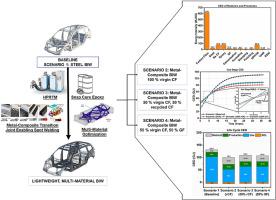轻量化多材料金属纤维复合材料混合白车身设计生命周期能量评价比较
IF 14.2
1区 材料科学
Q1 ENGINEERING, MULTIDISCIPLINARY
引用次数: 0
摘要
轻量化对于提高车辆效率和减少尾气排放至关重要。用于白车身(BIW)的纤维增强塑料(FRP)复合材料是实现轻量化的主要研究热点。FRP复合材料的制造工艺,如真空灌注或自动化纤维放置,不能满足汽车工业的速度,周期时间和大产量。从成本的角度来看,随着零部件尺寸和制造规模的增加,材料成本成为生产中的主导因素,抑制了昂贵复合材料的使用。因此,多材料结构设计已经占据了中心舞台,其中轻质材料和高速率复合材料制造工艺与传统金属设计相结合。采用独特的多材料金属纤维过渡接头开发了高度集成的多材料frp密集白车身设计,可实现复合材料部件的点焊。这使得制造多材料的白车身,对汽车制造商的装配和连接基础设施的改变最小,呈现出一种具有成本效益的复合材料集成解决方案。从可持续发展的角度来看,必须研究这些多材料设计和复合材料制造方法的生命周期影响,并将其与当代钣金设计进行比较。对采用快速循环复合制造工艺制造的多材料设计进行了全面的生命周期能量比较评估。确定多材料白车身整个生命周期的累积能源需求,为多材料白车身的材料组成提供了有价值的见解。它还有助于在使用能源密集型复合材料和由于轻量化而在使用阶段实现的能源节约之间建立权衡。本文章由计算机程序翻译,如有差异,请以英文原文为准。

Comparative life cycle energy assessment of lightweight multi-material metal-fiber composite hybrid body-in-white designs
Lightweighting is crucial for enhancing vehicle efficiency and reducing tailpipe emissions. Fiber-reinforced plastic (FRP) composites for the Body-in-White (BIW) are a major research focus aimed at achieving lightweighting. FRP composite manufacturing processes, such as vacuum infusion or automated fiber placement, cannot meet the automotive industry's rates, cycle times and large production volumes. From a cost standpoint, as component size and scale of manufacturing increase, material cost becomes the dominant factor in production, inhibiting the use of expensive composite materials. Thus, multi-material structural designs have taken center stage, where lightweight materials and high-rate composite manufacturing processes are strategically used in conjunction with traditional metallic designs.
A highly integrated multi-material, FRP-intensive BIW design was developed using unique multi-material metal-fiber transition joints that enable spot welding of composite parts. This allows a multi-material BIW to be manufactured with minimal change to the vehicle manufacturer's assembly and joining infrastructure, presenting a cost-effective solution to integrate composites. From a sustainability standpoint, the life cycle impact of these multi-material designs and composite manufacturing methodologies must be investigated and compared with contemporary sheet-metal designs. A comprehensive comparative life cycle energy assessment has been performed on the proposed multi-material designs manufactured using fast-cycle composite manufacturing processes. Determining the cumulative energy demand over the entire life cycle of the multi-material BIW provides valuable insights into the material composition of the multi-material BIW. It also helps establish a trade-off between the use of energy-intensive composite materials and the energy savings achieved during the use stage due to lightweighting.
求助全文
通过发布文献求助,成功后即可免费获取论文全文。
去求助
来源期刊

Composites Part B: Engineering
工程技术-材料科学:复合
CiteScore
24.40
自引率
11.50%
发文量
784
审稿时长
21 days
期刊介绍:
Composites Part B: Engineering is a journal that publishes impactful research of high quality on composite materials. This research is supported by fundamental mechanics and materials science and engineering approaches. The targeted research can cover a wide range of length scales, ranging from nano to micro and meso, and even to the full product and structure level. The journal specifically focuses on engineering applications that involve high performance composites. These applications can range from low volume and high cost to high volume and low cost composite development.
The main goal of the journal is to provide a platform for the prompt publication of original and high quality research. The emphasis is on design, development, modeling, validation, and manufacturing of engineering details and concepts. The journal welcomes both basic research papers and proposals for review articles. Authors are encouraged to address challenges across various application areas. These areas include, but are not limited to, aerospace, automotive, and other surface transportation. The journal also covers energy-related applications, with a focus on renewable energy. Other application areas include infrastructure, off-shore and maritime projects, health care technology, and recreational products.
 求助内容:
求助内容: 应助结果提醒方式:
应助结果提醒方式:


